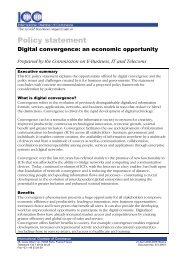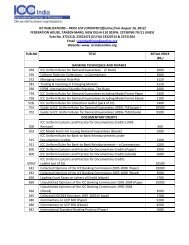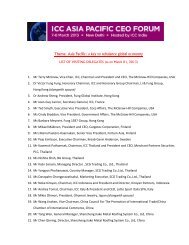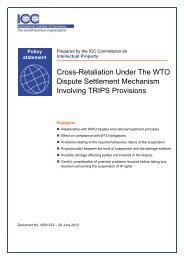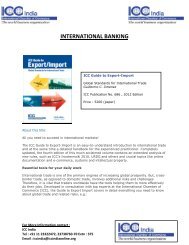2013 - ICC India
2013 - ICC India
2013 - ICC India
- No tags were found...
You also want an ePaper? Increase the reach of your titles
YUMPU automatically turns print PDFs into web optimized ePapers that Google loves.
<strong>ICC</strong> BANKING COMMISSION | <strong>2013</strong> GLOBAL RISKS TRADE FINANCE | APPENDIX B 41Basel IIIIn the wake of the financial crisis, the Bank for International Settlements putforward a set of reforms (Basel III) to increase the resilience of banks andto lay out measures for managing liquidity risk. Broadly, Basel III covers thefollowing six areas:1. Tier 1 capital requirements. Basel III sets out stricter rules governingacceptable forms of capital to ensure banks are in a better position toabsorb losses on both a “going concern” and “gone concern” basis.As a result, Tier 1 capital is to become mostly common shares andretained earnings (Common Equity Tier 1 or CET1). There will be limitedrecognition of deferred tax assets, minority interests, pension assets/liabilities, unrealised gains/losses, mortgage servicing rights andunconsolidated investments in financial institutions. Instead, there will bea 250% risk weighting on the portion of these items not deducted fromCET1. The minimum CET1 ratio is set at 7% (including a conservationbuffer), with a minimum Tier 1 ratio of 8.5% (including the conservationbuffer) and a total capital requirement of up to 10.5% (also including theconservation buffer).2. Risk coverage. There are additional capital requirements forcounterparty credit risk exposures arising from derivatives, repurchaseagreements and securities financing, as well as capital incentivesto move over-the-counter (OTC) derivative exposures to centralcounterparties (CCPs) and exchanges. The additional capital comes inthe form of:a. A credit valuation adjustment (CVA) capital charge for mark tomarket losses associated with the decrease in creditworthiness of acounterpartyb. An increase in counterparty credit risk charges for trades with otherfinancial institutions through a change in the asset value correlation(AVC) parameterc. Use of stressed expected positive exposure (EPE)d. New charges for wrong way riskBanks are, however, incentivised to move OTC derivatives to CCPs througha 2% risk weighting on CCP exposures.3. Cyclicality. Basel III is also intended to be a counter-cyclical frameworkto encourage banks to build up their capital buffers during good times.As such, a capital conservation buffer of 2.5% is required, togetherwith an additional countercyclical Tier 1 buffer of 0% to 2.5% to bedetermined by national regulators based on overall ratio of credit toGDP. Forward-looking provisioning will be required to capture actuallosses and reduce pro-cyclicality.4. Liquidity. A 30-day LCR must be reported at the group level in asingle currency, but must be monitored in all significant currencieswhere aggregate liabilities are greater than 5% of total liabilities. ANSFR must be reported for longer-term structural liquidity. In additionto these ratios, there is also a defined set of monitoring metrics toassist supervisors in identifying bank or system-wide trends, fundingconcentration and maturity profiles.



